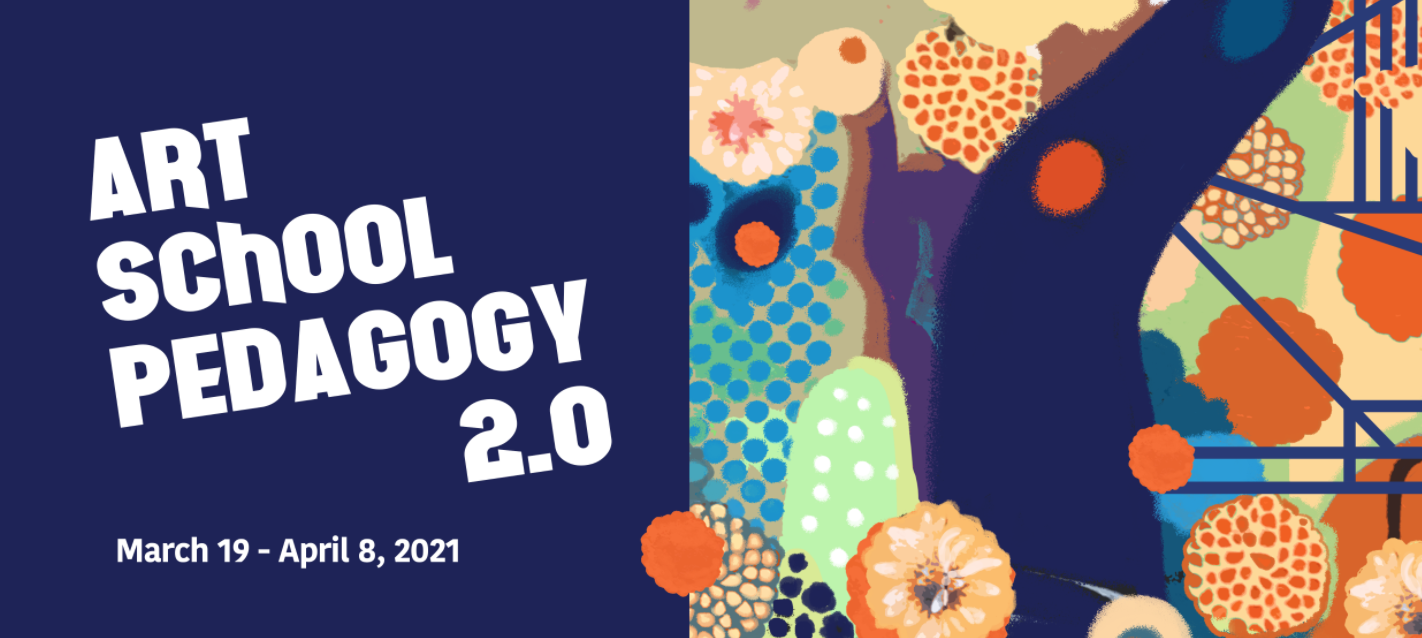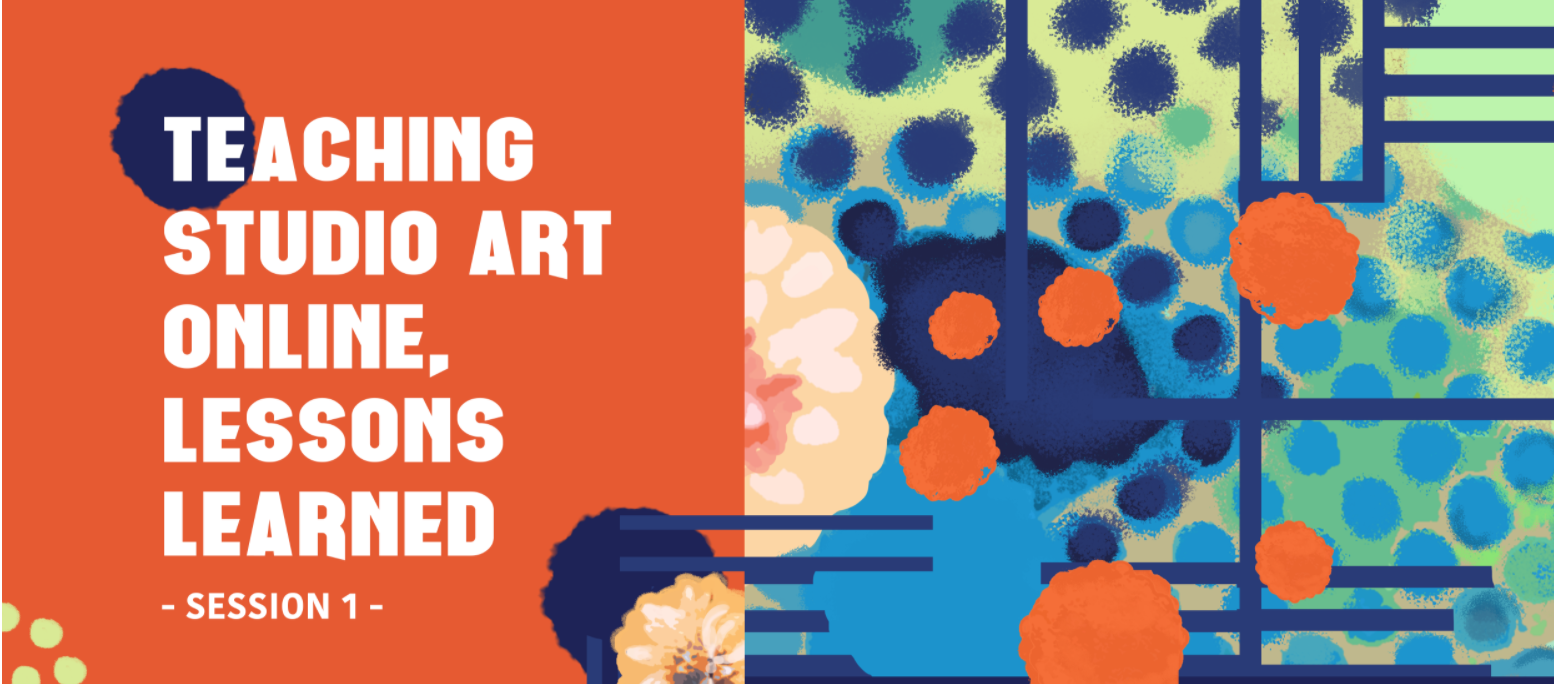Art School Pedagogy 2.0 - Session 1: Teaching Studio Online, Lessons Learned
“Sponsored by The Art and Art Education Program, Teachers College, Columbia University and the Maryland Institute College of Art (MICA), Art School Pedagogy 2.0 seeks to address the pedagogical challenges of studio art teaching pre- and post-pandemic. Organized into three sections, “Teaching Studio Online,” “Pedagogy as Mentorship,” and “Learning Cultures”, the Zoomposium focuses on a diversity of learning environments including higher education, public schools, and community art spaces.”
“Midway through the 2020 spring semester artists, students, and educators faced the unprecedented challenge of a global Covid pandemic. In this new environment, teaching studio classes online changed from an option to a necessity. One year into this digital experiment, we propose taking a collective moment to pause and reflect: What have we learned about studio teaching and learning online? What have been the unexpected successes of this format, and what have been the consistent challenges? What aspects of successful face-to-face instruction got lost in the shift? And how might we use this experience to alter future in-person studio classes for the better?”
Today was the 1st session of Art School Pedagogy 2.0 - Teaching Studio Online and the Lessons Learned. I was really excited about this symposium especially because of my interest in the following questions:
How do you teach art with the absence of direct tactility in a virtual setting? Is it true that the degree of direct tactility you lose with your students mean the lose of efficacy and increase in difficulty? Or is this my bias?
How much direct tactile engagement do students and teachers need in art education? Is it either you have it (together indoors or outdoors classroom) or you don’t (virtual)? Can it be somewhere in between - as in, the learning is virtual but the making/creative space is tactile? How are the teaching and the learning outcome different between on-site, hybrid, and fully remote?
How much efficacy is translated when art education moves from a tactile to virtual ecology? What does this shift mean for teaching art, learning art, making art, showcasing art, communicating art (among peers), the medium of art, and techniques of art?
Can art teachers have “successful” teaching and learning experiences in a virtual or a hybrid setting? How should art teachers redefine objectives and expectations of their pedagogy to meet the virtual ecology? Are there any positives and strengths that come from having this virtual ecology?
Panel Discussion #1 - Teaching Studio Online: International Perspectives
• Moderator – José Galarza (Maryland Institute College of Art, Baltimore)
• Panelists
• Rabeya Jalil (visual artist and art educator, National College of Arts, Lahore, Pakistan)
• Dina Lutfi (artist, graphic designer, and Assistant Professor of Graphic Design and Multimedia at Imam Abdulrahman Bin Faisal University, Saudi Arabia)
• Sangbin Im (professor at the Department of Painting at the College of Art, Sungshin University, Seoul, South Korea)
• Rainer Wenrich (Professor and Chair for Art Education and Art Didactics at Catholic-University Eichstaett-Ingolstadt)
• Eric Feng Fan (Associate Professor of art and deputy chair of Department of painting in Academy of Arts & Design, Tsinghua University, Beijing)
With such a diverse panelist, it was truly an international perspective on art education in the higher education setting.
Two most interesting takeaways —
1) Dina Lutfi mentioned that it was hard for her to ask students to turn their videos on especially since Saudi Arabia is culturally conservative. Historically, there is a social norm of guardianship in which women needs permission to obtain their education, and women have to wear hijabs. Also if I’m not mistaken, it’s illegal to take photos of women in a public space. So naturally, a country’s particular cultural climate would have an effect on the students’ level of familiarity and engagement via whichever virtual online learning platform.
2) Eric discussed a tool that Tsinghua University developed just before the pandemic which is a powerpoint app that students can engage with peers and professors beyond class time. Again pointing back to cultural climate, the university decided to create this app because students don’t participate or are vocal in class. Ironically this app has helped increase the level of engagement during the pandemic.
Also students have been setting up their studios and doing live drawing classes in their home, bringing the process into their most intimate spaces and relationships. This embedding created special bonds between students and their family members as they were seeing the students draw for the first time.
One participant/educator pointed out that this might not be the case for many students because they’re identities and their artwork are in direct opposition to their family’s culture and values. In this case, it would be difficult for students to set up studios at home.
Questions
Is it unethical to ask students to mandatorily turn on their video on zoom?
How do you address students’ and parents’ doubts about learning art online? Especially for higher ed in which the cost can be substantial.
What is the ideal studio space?
Panel Discussion #2 - Teaching Studio Online: Discipline-specific Approaches

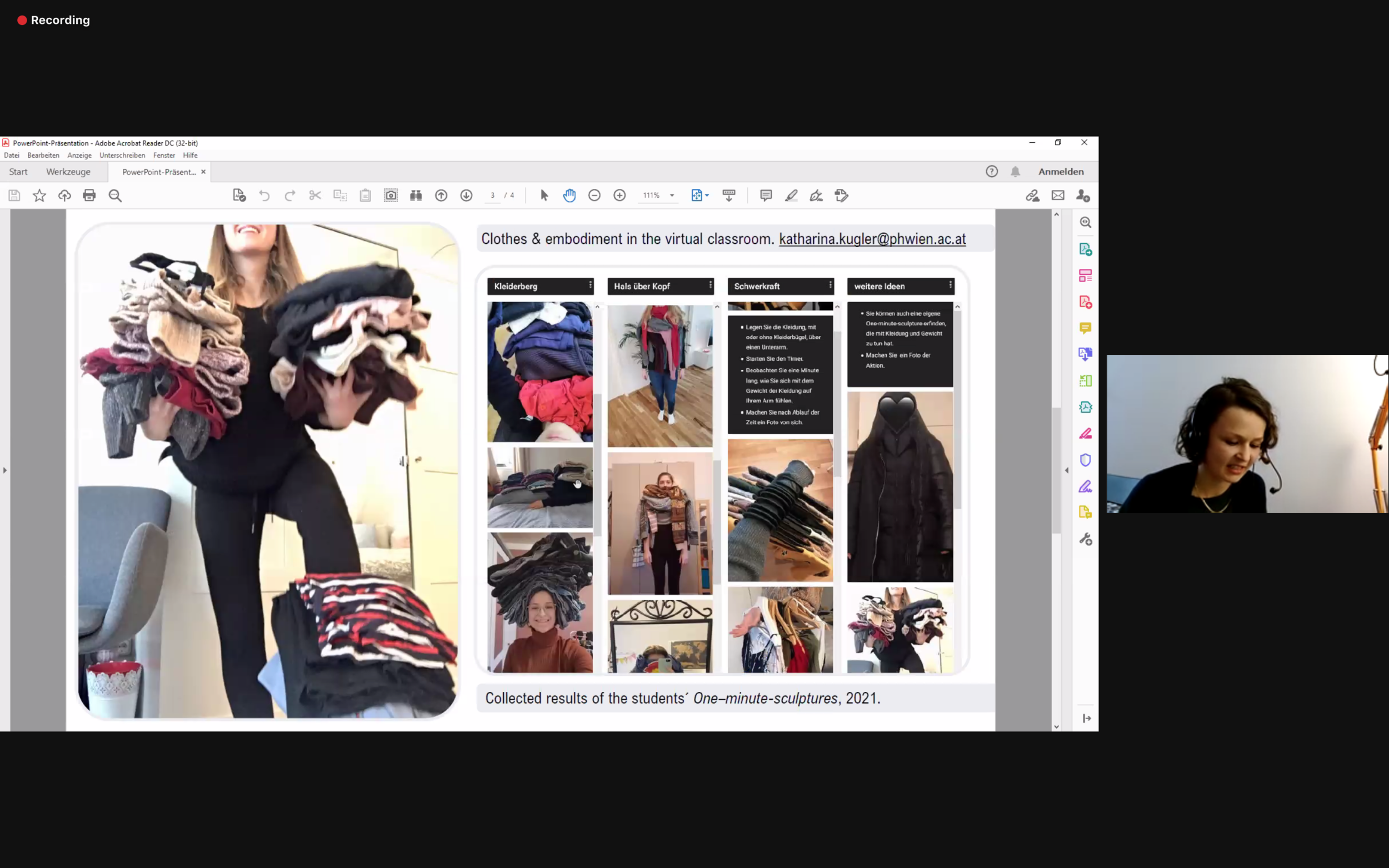
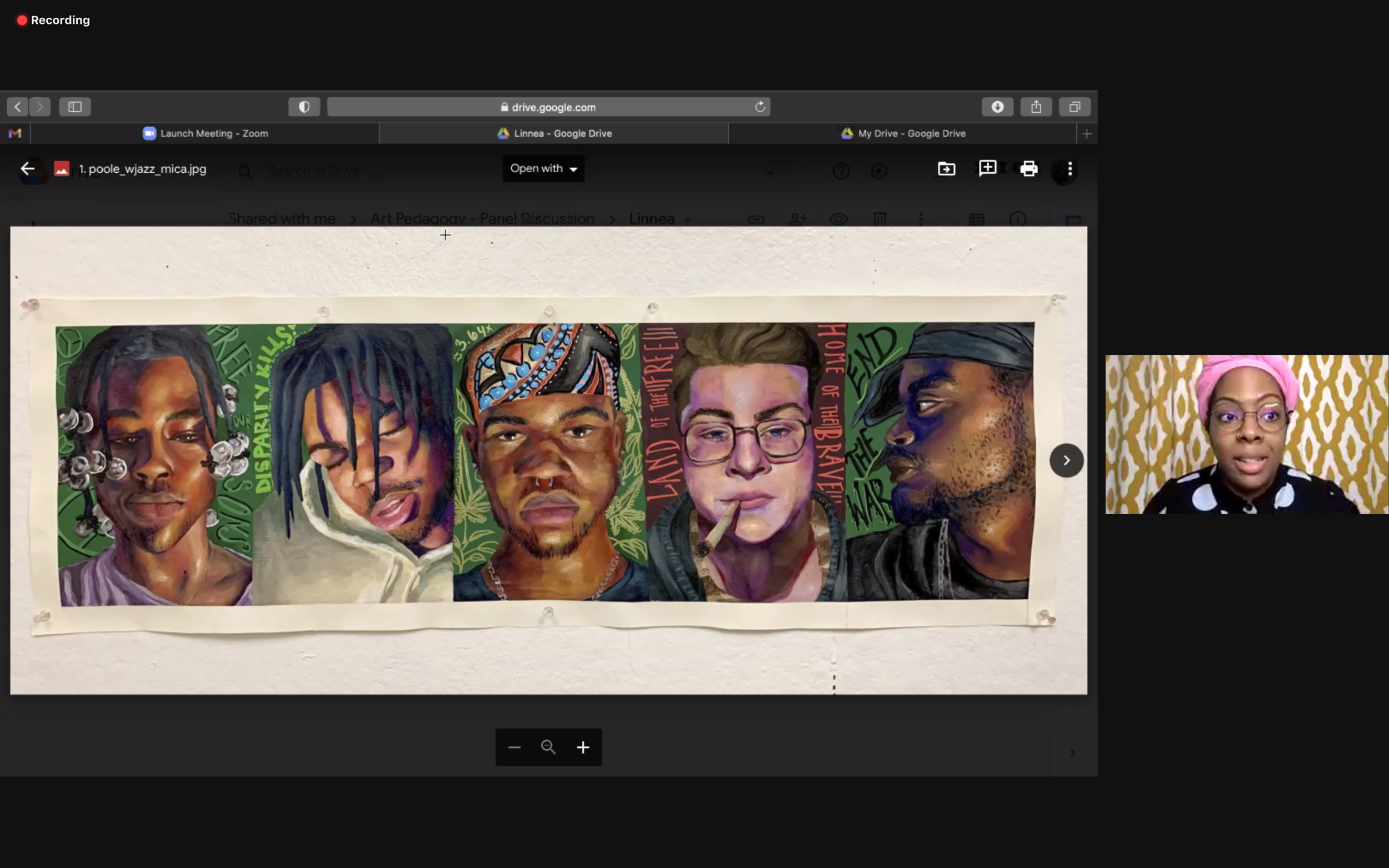


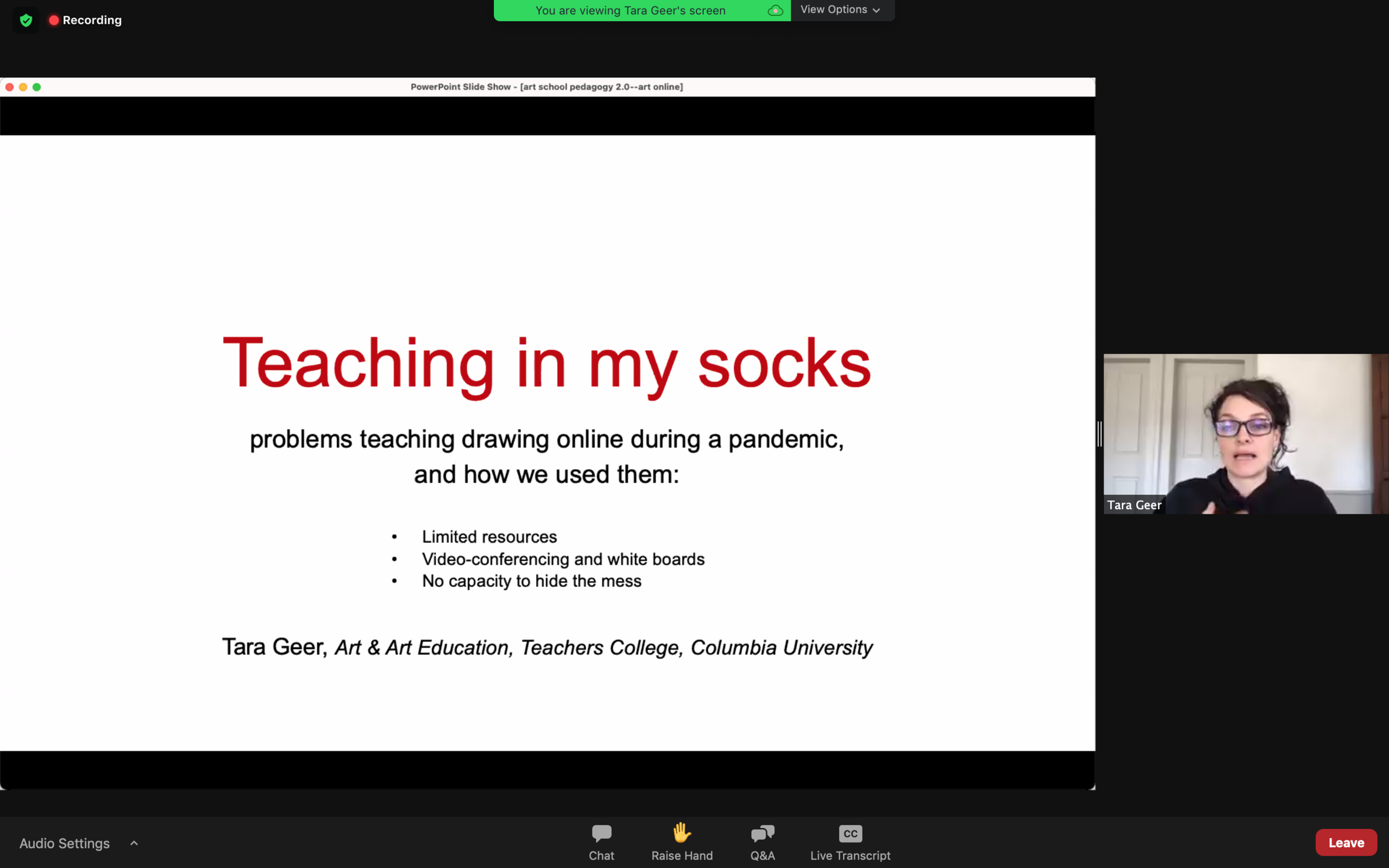
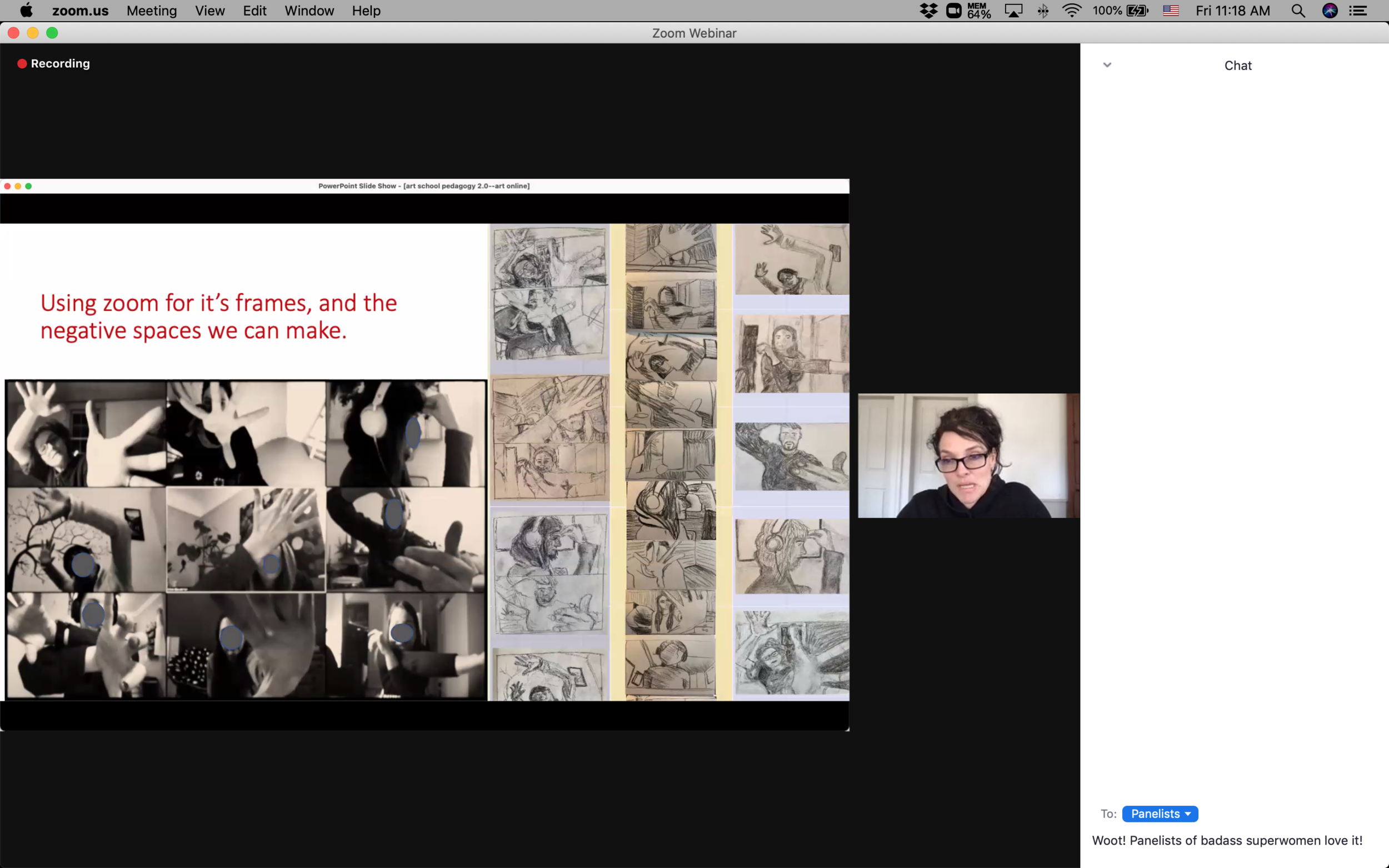
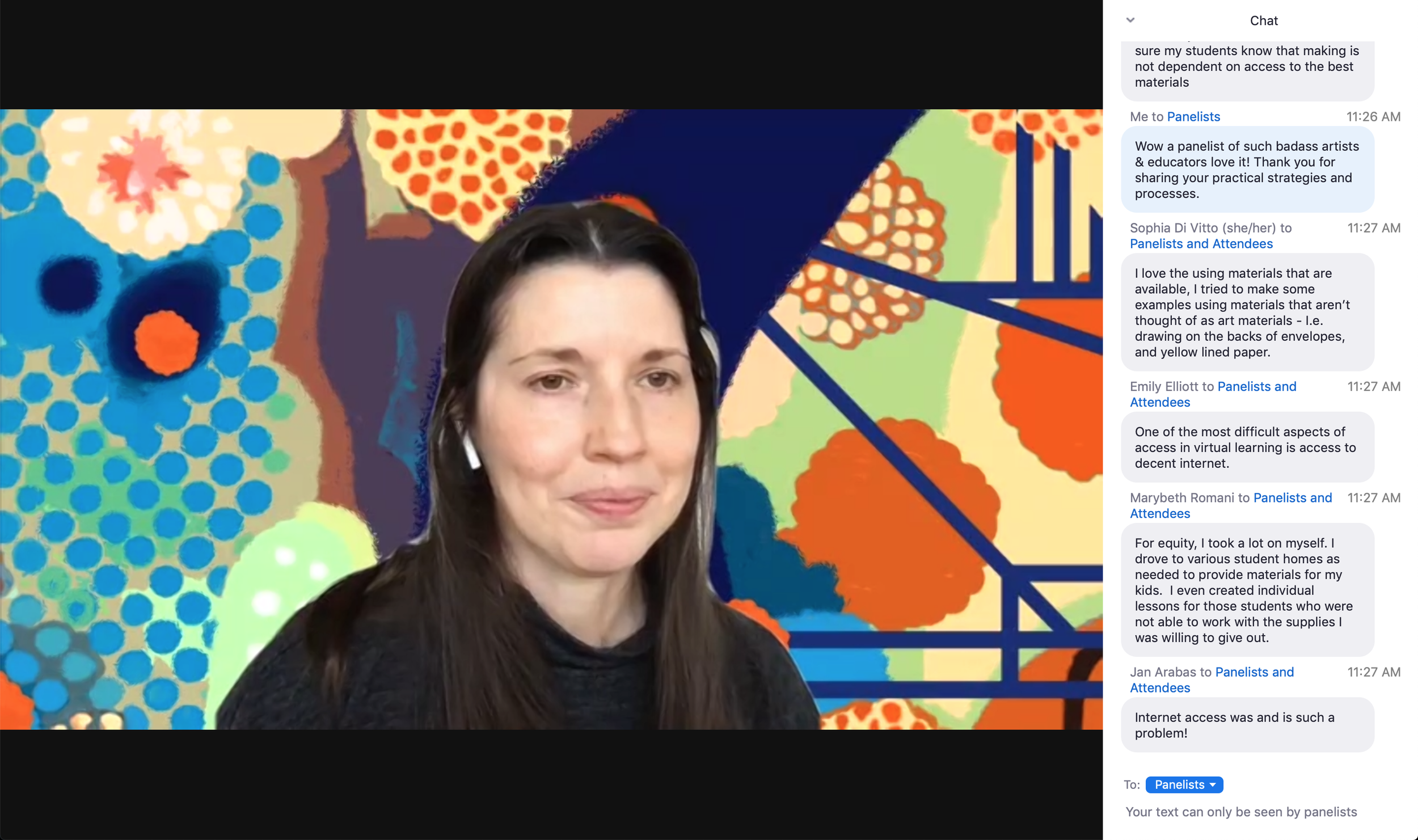
• Moderator – Aimee Ehrman (Teachers College, Columbia University, Ceramics)
• Panelists
• Raluca Iancu (Iowa State University, Printmaking)
• Katharina Kugler (University College of Teacher Education Vienna, Textiles)
• Tara Geer (Teachers College, Columbia University, Drawing)
• Linnea Poole (Maryland Institute College of Art, Social practice, multimedia, performance, community arts, dance)
What badass artists and educators they were. So inspired.
Since this was a media specific panel, I was extremely curious to how each panelist has taught ceramics, printmaking, drawing, fashion via virtual ecology. In media specific classes, there’s a healthy mix of mastering the technique and idea execution. So, how do you teach techniques via online? Or when in question of equity, students are geographically in different time zones and accessibility to materials vary?
Main most important take away — let go of ideals of highest quality material.
Features Topics in Parallel Sessions
I went to listen in on Topic #5 - Engaging K-12. It was a super practical session where art teachers shared tools, apps, resources, and materials they’ve been using during the pandemic.
Some of the resources shared:
Students filming their own diy videos for other students (This is so brilliant because they can learn the basics to How to Become a Youtuber.)
Pre-recorded videos as homework and teaching outside (Brilliant because this reduces time outside of actual making.)
Below are rest of the available topics to choose from
TOPIC #1: BLENDED LEARNING
Dr. Susan Connolly: Blended Learning, Digital Platforms and experimenting with best practice in our new online studio teaching environment
Within this presentation I am going to reflect upon methods of blended learning within studio teaching and what could be possible within our future post covid teaching environments. Over the past year and through the experience of living and adapting to covid I now see that it wasn’t a case that we couldn’t incorporate blended learning techniques and methods but rather that the will and commitment needed for such a shift in our teaching delivery was never really discussed, considered or debated, let alone supported, researched or funded. So, the very steep learning curve we have all had to bend to since March 2020, although often extremely difficult, now poses us with new and exciting knowledge of how a future within art education could emerge for this crisis. Proposing and hopefully creating a more dynamic and inclusive place for the future of education in the Visual Arts and beyond.
TOPIC #2: ACTIVATING COMMUNITIES
Jasmin Schaitl: Performance in Schools, an online format, working with the physical body
The practice-based lecture "Experimental Laboratory: Performance in Schools" at the University of Applied Arts in Vienna at the Center for Didactics of Art and Interdisciplinary Education was realized with eight students through zoom for one semester. Teaching via an online platform revealed the inherent performative potential of online exchanges, that consists of plenty of interactive qualities realized and experienced by students. Connecting online provided the possibility to interact and act performatively within the private living space, that became an artistic space of discovery and learning. Working within performance was a new field for the majority of art and art-pedagogy students. Their living space offered privacy when trying out exercises with the body and when diving into artistic discovery of new formats. Students experienced interactive methods through live-video arrangements and developed exercises for online and physical encounters. Realized and developed by Jasmin Schaitl (artistic researcher at DEMEDARTS Project A-609, funded by the Austrian Science Fund).
TOPIC #3: RE-IMAGINING THE CRITIQUE
Sam Bennett and Ari Elefterin
What is the goal of the critique? How can the critique uplift and empower BIPOC, LGBTQIA+, and immigrant voices? The critique is a place where hierarchy, exclusion, and privilege are perpetuated. Now is the time for us to radically re-envision these practices. In this dynamic and participatory session, we will explore ways to examine and deconstruct current critique structures in order to rebuild inclusive, equitable, and student-centered feedback spaces. Sam Bennett and Ari Elefterin will share findings from their generative workshop series titled “Re-Imagining the Critique” held in 2020 at Parsons School of Design.
TOPIC #4: ON RESEARCH
Siân Evans and Mackenzie Salisbury: Not Your Mother’s Research Class: Challenging the Status Quo in Art and Design Research
Pivoting to online instruction provided educators in co-curricular roles, like librarians, new opportunities to collaborate with teaching faculty to highlight previously underutilized online pedagogical tools and open access resources. In this presentation, two librarians at Art and Design Colleges will discuss how they partnered across departments to reframe their roles and how this can continue to benefit students even after we return to more traditional models of instruction. Additionally, they will showcase this shift in the status quo with examples like utilizing existing online tools not intended for higher ed, adopting digital literacy pedagogical strategies (e.g. lateral reading), and leveraging open source and open access technologies to center student-driven creative content in the research process. All of this illustrates the potential for creative practice research online in 2021 and beyond.
TOPIC #5: ENGAGING K-12
CJ Reilly III: Building the Virtual Art Classroom on The Fly During the Year of Remote Learning
This presentation explores my collective experiences in designing immersive elementary art education over Zoom and Google Classroom. I reflect on the successes and failures in remote teaching in an effort to answer a few essential questions: 1) What are the unique challenges posed by remote art education vs other subjects? 2) How can art teachers create and sustain meaningful student-centered learning throughout the school year? 3) How can art teachers promote meaningful collaboration between remote learners? 4) How can art teachers balance the demands of a hybrid classroom? 5). I will also share my work-in-progress curricula from a year of near-constant tinkering, iterating, and sometimes- trips back to the drawing board.
TOPIC #6: HARD LESSONS LEARNED
Stephanie Barber
Barber will speak about some of the hard lessons she learned during her year as the Interim Director of the Mount Royal Graduate School of Multidisciplinary Arts at MICA in Baltimore. Planning and beginning the year as in-person learning and then moving rapidly to an online platform provided unexpected insights, challenges and steep learning curves. From the very pesky technical challenges of online learning and connectivity to the more philosophical realizations about student’s emotional and attentive bandwidth, the smalling of our globe and the financial impact the virus has on our economies are a few of the hard lessons she learned.
TOPIC #7: ACTIVATED LEARNING
Dr. Hwa Young Caruso: Sharing Experiences of Online Teaching Studio Art in College
My presentation focuses on teaching online studio art and art history in Canvas at Molloy College, NY during Fall 2020 and Spring 2021. The undergraduate studio art classes were Drawing, 2D Design, Watercolor Painting, Printmaking, Senior Thesis Project. It was a challenge to teach studio art 100% online and maintain academic rigor. I was certified as an Online Instructor in Canvas after learning module design, creating online lessons, assessments, conducting Zoom discussions and critiques, uploading PPP, converting documents, integrating videos and hyperlinks, uploading art history and student artworks images. I was reborn and excited as an online studio art professor and realized relationship building with students in a virtual environment was impeded by technology which took priority over human emotions. The nurturing environment and the community of art practitioners were missing. Student’s work space for creating artworks was limited. My professional identity transformed into an online instructor and I felt proud.
